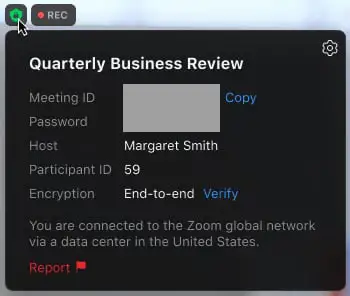KEEP IN TOUCH
Subscribe to our mailing list to get free tips on Data Protection and Cybersecurity updates weekly!







Zoom has announced today the rollout of new security enhancements designed to help meeting hosts to block zoombombing attempts and participants to report misbehaving users.
The Zoom video conferencing software has become an extremely popular way to keep in touch with family and friends since the start of the pandemic, with the company reporting in April that its platform reached 300 million daily users.
Zoombombing happens when Zoom meetings are joined by unauthorized third parties with the goal to disrupt ongoing sessions and harass participants.
The first new security feature added by Zoom, dubbed Suspend Participant Activities and enabled by default for all Zoom users, allows hosts and co-hosts to temporarily pause meetings and quickly remove any disruptive participants.
By clicking the ‘Suspend Participant Activities’ button under the Security icon, hosts will be able to immediately end all video, audio, in-meeting chat, annotation, screen sharing, recording, and Breakout Rooms activities.
“The hosts or co-host will be asked if they would like to report a user from their meeting, share any details, and optionally include a screenshot,” Zoom explained. “Once they click ‘Submit,’ the reported user will be removed from their meeting, and Zoom’s Trust & Safety team will be notified.”
Also Read: A Look at the Risk Assessment Form Singapore Government Requires
The second feature, known as Report by Participants, also makes it possible for meeting participants to report zoombombing trolls by clicking the Security badge on the top-left side of the Zoom client window.

While not enabled by default, ‘Report by Participants’ can be enabled by admins and account owners from the web settings.
The new security enhancements are immediately available to all users of Zoom desktop clients for macOS, Windows, Linux, and mobile apps, with web client and VDI users to get access later this year.
Starting this fall, Zoom’s newly deployed ‘At-Risk Meeting Notifier’ will also automatically alert account owners via email of Zoom Meeting links at a high risk of being disrupted.
Starting April 4, Zoom enabled a Waiting Room feature that allows hosts to control when participants join meetings and now requires a password when scheduling new meetings, instant meetings, or webinars.
These measures were taken to help Zoom users guard against the rising threat of Zoom-bombing incidents as the FBI warned on March 30.
The Department of Justice warned that Zoom-bombing is illegal and that those involved can be charged with federal and state crimes that may lead to fines and/or imprisonment.
Zoom also added two-factor authentication (2FA) support to all accounts in September and end-to-end encryption (E2EE) last month.
BleepingComputer provides an exhaustive guide on the steps required to properly secure online meetings from Zoom-bombing attacks.
Also Read: How To Send Mass Email Without Showing Addresses: 2 Great Workarounds